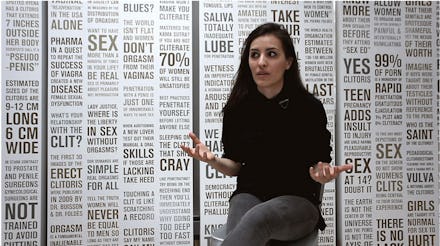This Art Project Will Teach You Cliterally Everything You Need to Know About the Clitoris

Sophia Wallace didn't anticipate becoming an internationally celebrated "clit artist," but she did, thanks to her 2012 mixed media project CLITERACY, which has blossomed through the years, recently finding a new audience through a digital collaboration with the Huffington Post.
"I wouldn't say it was easy to take on this subject matter, to be the 'clit artist.' I worried, rightly, that I would lose professional credibility, that doors would slam in my face," she said in an interview with Mic.
"I created CLITERACY because I was haunted by the lack of the clitoris in visual representation and speech," Wallace said, noting that the clitoris was not medically recognized until 1998. Calling it the "true female sexual organ," because, as the location of 8,000 nerve endings, it is the epicenter of female pleasure.
Yet the clitoris has been overlooked, ignored and dismissed throughout human history, especially because women's sexuality outside of men's sexual needs is so rarely considered. "The effect of never hearing the word clitoris in education," Wallace said, "never seeing representations of it in visual culture, not even discussing it with the doctor, is that women eventually trust a false canon of knowledge more than their own bodies."
Recognizing the clit means that women "have body sovereignty, autonomous sexuality and ... dignity." CLITERACY, in tandem with the Huffington Post's digital media platform, serves to educate and delight both men and women on the power of the clitoris.
What is the clitoris? "A large, mostly internal organ," Wallace said, "comprised of erectile tissue and has a direct blood supply that allows it to have orgasm after orgasm after orgasm." Because the "clitoris is like an iceberg with 8,000 nerves in its tip and more inside," it happens to be the most sensitive body part. The g-spot, which modern culture has interpreted as the holy grail of female pleasure, is actually just an internal part of the clitoris. "Any pleasure through penetration occurs not from the vagina (which has very few nerves)," Wallace observed, "but from the internal clitoris which is activated through the glans of the clitoris."
The clitoris is not the vagina. "The word 'vagina,' used for women's genitalia is a Latin word meaning sword holder and only describes the inside, the birth canal," Wallace elaborated. "The word 'vagina' excludes the female sexual organ, the clitoris."
Becoming "cliterate" in four steps: Wallace, who composed the "100 Natural Laws" of CLITERACY, "which are like the Universal Declaration of Rights for the clitoris to exist free of harm," she said, outlined a four-step process in becoming "cliterate."
1) Learn the anatomy of the clitoris and that "the glans of the clitoris and the glans of the penis are homologous."
2) Apply this knowledge to all of your sexual encounters. "This means treating the clitoris as the alpha and omega of their pleasure, always engaging it as a star, never as an afterthought, never as a warm-up," Wallace said.
3) Acknowledge the clit's existence. "Refus[e] not to see it," Wallace intoned, and "speak up for it when others try to negate it or [reference] female genitals as an insult."
4) Realize that everyone has the right to pleasure in sex, and, Wallace said, "to have their body treated with dignity."
The politics of cliteracy: Historically, Wallace explained to Mic, "the female body has been constructed as solely existing to provide sexual labor and reproductive labor. It has not been respected as autonomous, nor has it occurred to many that it is capable of and quite naturally enjoys pleasure for itself only." This has unfortunately resulted, she said, in a fair amount of misogynist backlash as Wallace has displayed her art in museums and on streets across the continent. "For some [people], the discovery of a clitoris sculpture in public is met almost immediately with rape threats and calls for its destruction."
Which is why projects like CLITERACY are so crucial to women's equality — because equal rights are just as much about the bedroom as they are about the boardroom.